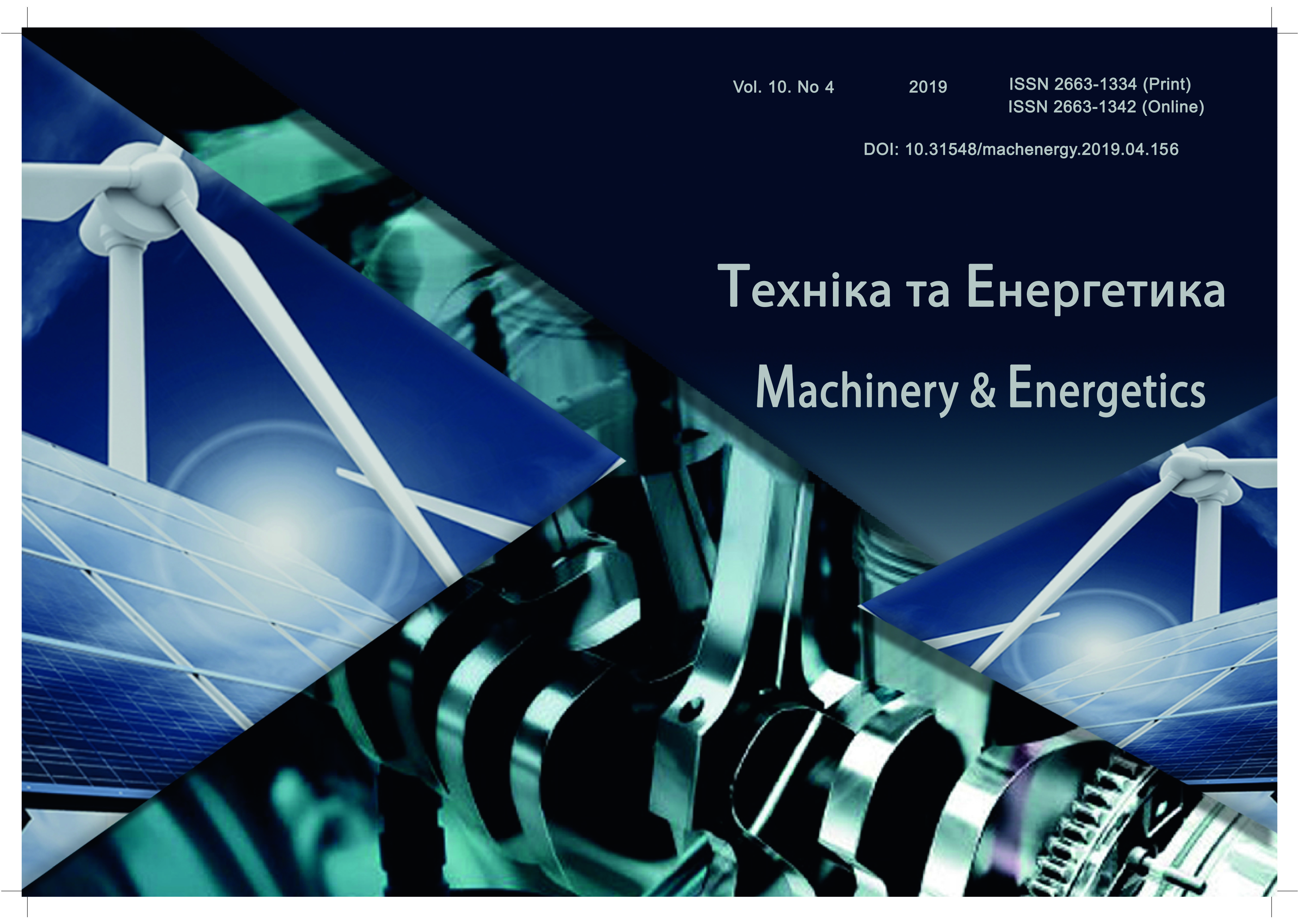Theoretical justification of regulation of borrowing submission for handling holes
DOI:
https://doi.org/10.31548/machenergy2019.04.085Keywords:
feed, hole, axial force, drilling.Abstract
The purpose of the study is to substantiate the need to change the feed of the drill at its exit from the part taking into account the rigidity of the vertical-drilling machines, the physical and mechanical properties of the workpiece material, sharpening drills and more. The object of the study is the technological process of drilling through holes on machines with mechanical feed. The subject of the study is the regularity of the process of drilling through holes and the influence of cutting modes on them.
The paper presents theoretical dependencies for the purpose of feeding depending on the diameters of the drills used, the determination of the zone from which it is necessary to reduce the flow, the determination of the values of the axial force when drilling the hole.
Theoretical dependences were obtained to determine the values of the machine feeds, depending on the diameter of the drill, taking into account various restrictions, namely: the stability and strength of the drills, the strength of the machine feed mechanism, as well as to determine the size of the zone of production, when reaching the drill which must reduce the flow.
Results: It is found that to increase the operational reliability of the drill bits and to protect them from breakage, it is necessary to automatically reduce the feed size at the outlet of the tool.
References
Nagornyak S. G., Lutsiv I. V. (1987). Usinage de trous de grand diamètre avec des outils cinématiques adaptatifs. Technologie et organisation de la production. N ° 4. 27-29.
Kosilova, A. G. (1995). Technologue-constructeur de machines de référence: en 2 t. Kosilova, R.K. Meshcheryakov. M .: Ingénierie. T. 2. 1985. 495.
Yashcheritsyn, P. I. (1981). Bases des matériaux de coupe et des outils de coupe. P. I. Yascheritsyn, L. M. Eremenko, N. I. Zhigalko. Mn.: Vysh. École, 560.
Bobrov V. F. (1975). Fondements de la théorie de la coupe du métal. M. Génie mécanique, 344.
Vasin S. A., Vereshchak A. S., Kushner V. S. (2001). Coupe du métal: approche thermodynamique du système de relations dans la coupe: Manuel. pour les universités de technologie. M.: Maison d'édition de MGTU im. N. Z. Bauman, 448.
Granovsky G. I., Granovsky V. G. (1985). Coupe de métal. M .: École supérieure, 304.
Kragelsky I. V. (1968). Friction et usure. M.: Génie mécanique, 480.
Kozhevnikov D. V., Kirsanov S. V. (2007). Coupe de métal. M .: Ingénierie, 303.
Loladze T. N. (1958). Usure d'un outil de coupe M.: Mechanical Engineering, 480.
Loladze T. N. (1982). Résistance et résistance à l'usure d'un outil de coupe M.: Mechanical Engineering, 320.
Makarov A. D. (1966). Optimisation des processus de coupe. M .: Engineering, 278.
Poduraev V. N., Kamalov V. S. (1973). Méthodes de traitement physico-chimiques. M .: Engineering, 346.
Theory of Rezannya: The First Courier. Zhytomyr (2006): ZhDTU, 250.
Armorego I. J., Brown R. H. (1977). Cutting materials. Per. from English M.: Engineering, 329.
Garkunov D. N. (1989). Tribotechnology. M.: Engineering, 328.
Ostafiev V. A. (1979). Calculation of the dynamic strength of the cutting tool. M.: Mechanical engineering, 168.
The physical basis of the metal cutting process. Ed. Ostafieva V. A. (1976). K.: Higher school. 135.
Yakimov A. V., Slobodiannik P. T., Usov A. V. (1991). Thermophysics of machining. TO.; Odessa: Lybid, 240.
Reznikov A. N. (1981). Thermophysics of the processes of mechanical processing of materials M.: Mechanical Engineering, 279.
Rosenberg Yu. A. (2007). Cutting materials. The textbook for tech. Universities. Kurgan: Publishing House OJSC Printing. Zauralie. 294.
Lizard P. I., Eremenko M. L., Feldstein E. Z. (1990). Theory of cutting. Physical and thermal processes in technological systems. Minsk: High. school. 512.
Downloads
Published
Issue
Section
License
Relationship between right holders and users shall be governed by the terms of the license Creative Commons Attribution – non-commercial – Distribution On Same Conditions 4.0 international (CC BY-NC-SA 4.0):https://creativecommons.org/licenses/by-nc-sa/4.0/deed.uk
Authors who publish with this journal agree to the following terms:
- Authors retain copyright and grant the journal right of first publication with the work simultaneously licensed under a Creative Commons Attribution License that allows others to share the work with an acknowledgement of the work's authorship and initial publication in this journal.
- Authors are able to enter into separate, additional contractual arrangements for the non-exclusive distribution of the journal's published version of the work (e.g., post it to an institutional repository or publish it in a book), with an acknowledgement of its initial publication in this journal.
- Authors are permitted and encouraged to post their work online (e.g., in institutional repositories or on their website) prior to and during the submission process, as it can lead to productive exchanges, as well as earlier and greater citation of published work (See The Effect of Open Access).

